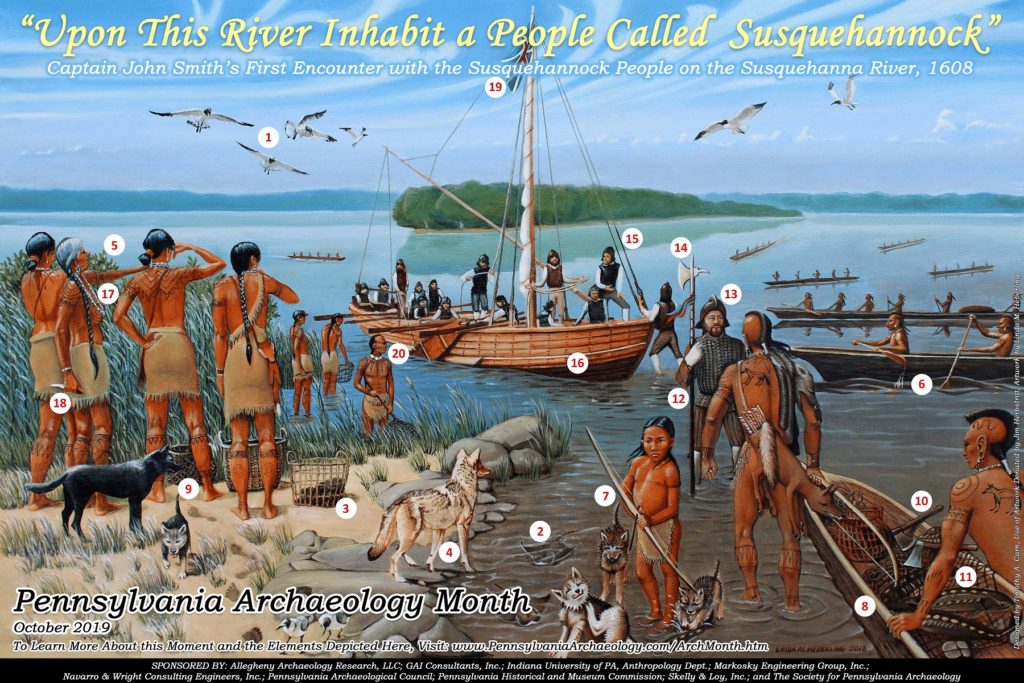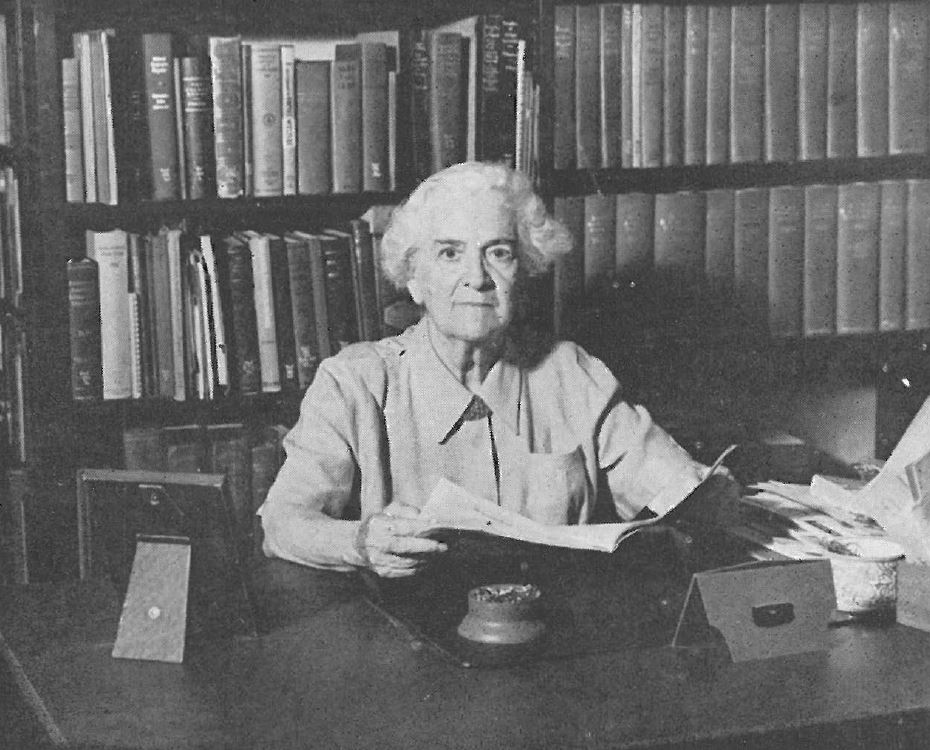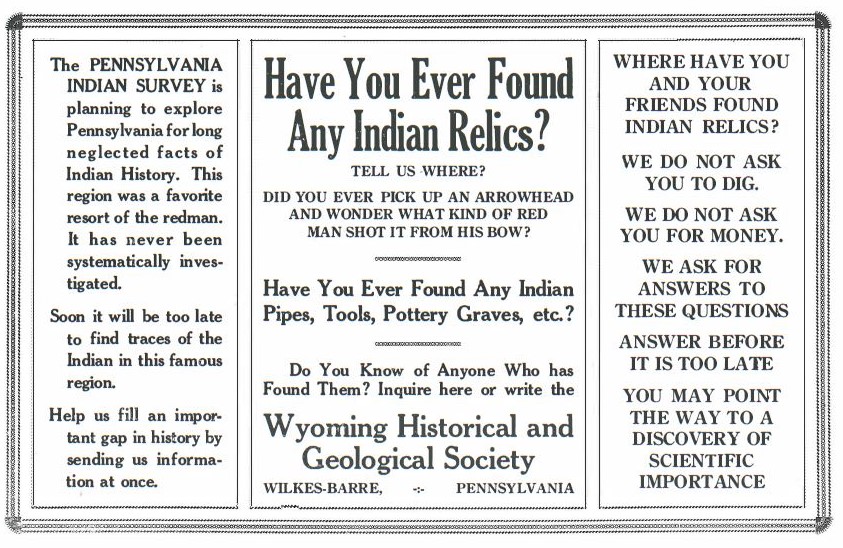In 1929, the Society for Pennsylvania Archaeology (SPA) was formed to promote the study of archaeology within the Commonwealth. Throughout the history of the SPA, up to and including today, the SPA has provided a forum for amateur and professional archaeologists to work together, share their findings, and piece together the archaeology of Pennsylvania.
To celebrate the SPA’s 90th year, and to celebrate October as Archaeology Month, we are taking over the blog of the Pennsylvania State Historic Preservation Office for two weeks. This week we will dive into the rich history of the society and look at some of the founding members. Next week we will look at what the SPA looks like in its 90th year and ways in which you can get involved.
What is Archaeology Month?
Archaeology Month, which is celebrated every October in many states, is sponsored in the commonwealth by PHMC, SPA, and the Pennsylvania Archaeological Council (PAC). Its purpose is to increase awareness of the important historic and prehistoric archaeological sites in the commonwealth, which are part of the heritage of all Pennsylvanians.
There are a number of free and open-to-the-public Archaeology Month events throughout October throughout Pennsylvania. more Pennsylvanians become aware of this part of our history and work to protect our endangered resources. Check out our website for a list of events.

Frances Dorrance and the Indian Site Survey
The story of the SPA starts not in 1929, but in 1924 in the town of Wilkes Barre, Luzerne County, in northeast Pennsylvania. And, any conversation about the founding of the SPA revolves around one figure, Frances Dorrance.

Frances Dorrance was the director of the Wyoming Historical and Geological Society of Wilkes Barre in the 1920s. She was keenly aware that Native American sites in New York and Ohio were being explored by archaeologists, but not in Pennsylvania. Dorrance knew that her state held the same deep history as neighboring states, and to explore this history she established the Indian Site Survey.
In 1924, Dorrance mailed 13,000 letters and questionnaires to post masters, teachers, boy scout troop leaders, and anyone else that may have been interested in archaeology. The mailing only went out to addresses in the forty-one eastern counties of the state. The 1,900 responses showed that there was a larger interest in the archaeology of Pennsylvania.
Frances Dorrance’s Indian Site Survey was the start of the Pennsylvania Archaeological Site Survey (PASS) program, This was only the start to what Frances had envisioned. In addition to the mail survey, Frances Dorrance envisioned excavation of sites under the direction of trained archaeologists.
The Beginning of SPA
Fast forward to March 9, 1929. Frances Dorrance sent out the following letter to the people who had responded back to the initial Indian Site Survey:
Because of your interest in archaeology, and as a collector of Indian artifacts, will you help us organize a Pennsylvania State Archaeological Society? We believe that an organization of this kind will not only benefit the collectors throughout the State by this means of exchange of ideas and information, but it will also strengthen and give enthusiasm to those who have already struggled individually in collecting Indian artifacts. By thus keeping in touch with each other, collectors in all parts of the State will know what is being discovered. The plan would be to have meetings in different parts of the State, with addresses and conferences, the addresses to be published and distributed among the members of the Society-probably in pamphlet form, the details to be worked out by a group of charter members.[1]
Like much of the information regarding the founding of the SPA in this blog post, this text was taken from J. Alden Mason’s Pennsylvania Archaeologist article entitled “Why Our Society Was Founded: An Appreciation”. The article appeared in the June 1955 Issue (Vol 25, No 1).
After a few preliminary meetings and a lot of planning, on Monday, May 6, 1929, at 2:05 p.m., Frances Dorrance called to order the first meeting of the SPA. In attendance were 19 members, many of which would go on to become pillars of Pennsylvania’s archaeology community. The first issue of Pennsylvania Archaeologist, the SPA’s bulletin/journal, was published in June of 1930.
Pennsylvania Archaeologist
During the early years of the SPA, the society grew and took shape as the membership shared their findings from across the state. The early issues of Pennsylvania Archaeologist testify to the diversity of the membership, with articles ranging from scientific discussions of ethnography to collectors looking to trade artifacts.
The real impact during the early years of the SPA’s journal was its role in documenting the work of archaeologists, most of whom were not professionals. It was during this time that the pre-history of Pennsylvania was painstakingly charted, compared, and argued over.

Over the years, Pennsylvania Archaeologist and the work of SPA members would set an example for other state and regional archaeology societies. The journal would grow to become one of the leading regional technical publications in the United States, attracting articles from throughout the Mid-Atlantic and Northeastern regions.
SPA’s Growth
In the modern era, with the rapid increase in professional archaeologists in the commonwealth caused by environmental legislation and proximity to some of the country’s top university archaeology programs, the society has become a forum for discussing, promoting, and learning about the archaeology of Pennsylvania. After 90 years, Frances Dorrance’s vision for the SPA still holds true.

That concludes our whirlwind tour of the founding and early history the SPA. Unfortunately, to list all of the members of the society who shaped it and were instrumental in the society’s growth is beyond the scope of this meager blog post. Next week, we will take a look at what the SPA looks like today, and how you can get involved.
Growing up roaming the hills of western Pennsylvania, this week’s guest author, Jonathan Libbon, knew from an early age that archaeology was for him. He is currently a professional archaeologist at SWCA Environmental Consultants. He has been a member of the SPA since 2007 and is involved with the Allegheny Chapter (Chapter 1). His interests range from industrial to landscape archaeology but is passionate about pretty much all of Pennsylvania Archaeology.
Leave a Reply